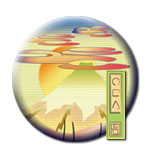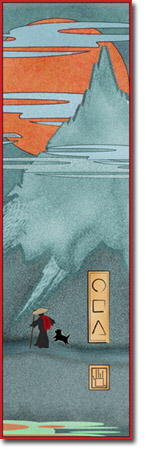On The Way: The Daily Zen Journal
Wake-up Sermon Part 1
Bodhidharma (d 528)
The essence of the Way is detachment. And the goal of those who practice is freedom from appearances. The sutras say, “Detachment is enlightenment because it negates appearances.” Buddhahood means awareness. Mortals whose minds are aware reach the Way of Enlightenment and are therefore called buddhas. The sutras say, “Those who free themselves from all appearances are called buddhas.” The appearance of appearance as no appearance can’t be seen visually but can only be known by means of wisdom. Whoever hears and believes this teaching embarks on the Great Vehicle and leaves the three realms.
The three realms are greed, anger, and delusion. To leave the three realms means to go from greed, anger and delusion back to morality, meditation and wisdom. Greed, anger, and delusion have no nature of their own. They depend on mortals. And anyone capable of reflection is bound to see that the nature of greed, anger, and delusion is the buddha-nature. Beyond greed, anger, and delusion there is no other buddha-nature. The sutras say, “Buddhas have only become buddhas while living with the three poisons and nourishing themselves on the pure Dharma.” The three poisons are greed, anger, and delusion.
The Great Vehicle is the greatest of all vehicles. It’s the conveyance of bodhisattvas, who use everything without using anything, and who travel all day without traveling. Such is the vehicle of buddhas. The sutras say, “No vehicle is the vehicle of buddhas.”
Whoever realizes that the six senses aren’t real, that the five aggregates are fictions, that no such things can be located anywhere in the body understands the language of buddhas. The sutras say, “The cave of five aggregates is the hall of zen. The opening of the inner eye is the door of the Great Vehicle.” What could be clearer?
Not thinking about anything is zen. Once you know this, walking, standing, sitting, or lying down, everything you do is zen. To know that the mind is empty is to see the buddha. The buddhas of the ten directions have no mind. To see no mind is to see the buddha.
To give up yourself without regret is the greatest charity. To transcend motion and stillness is the highest meditation. Mortals keep moving, while arhats stay still. But the highest meditation surpasses that of both mortals and arhats. People who reach such understanding free themselves from all appearances without effort and cure all illnesses without treatment. Such is the power of great zen.
Using the mind to look for reality is delusion. Not using the mind to look for reality is awareness. Freeing oneself from words is liberation. Remaining unblemished by the dust of sensation is guarding the Dharma. Transcending life and death is leaving home. Not suffering another existence is reaching the Way. Not creating delusions is enlightenment. Not engaging in ignorance is wisdom. No affliction is nirvana. And no appearance of the mind is the other shore.

When you’re deluded, this shore exists. When you wake up, it doesn’t exist. Mortals stay on this shore. Those who discover the greatest of all vehicles stay on neither this shore nor the other shore. They’re able to leave both shores. Those who see the other shore as different from this shore don’t understand zen.
Delusion means mortality. And awareness means buddhahood. They’re not the same. And they’re not different. It’s just that people distinguish delusion from awareness. When we’re deluded, there’s a world to escape. When we’re aware, there’s nothing to escape.
In the light of the impartial Dharma, mortals look no different from sages. The sutras say that the impartial Dharma is something that mortals can’t penetrate and sages can’t practice. The impartial Dharma is only practiced by great bodhisattvas and buddhas. To look on life as different from death or on motion as different from stillness is to be partial. To be impartial means to look on suffering as no different from nirvana because the nature of both is emptiness. By imagining they’re putting an end to suffering and entering nirvana, arhats end up trapped by nirvana.
But bodhisattvas know that suffering is essentially empty. And by remaining in emptiness, they remain in nirvana. Nirvana means no birth and no death. It’s beyond birth and death and beyond nirvana. When the mind stops moving, it enters nirvana. Nirvana is an empty mind. Where delusions don’t exist, buddhas reach nirvana. Where afflictions don’t exist, bodhisattvas enter the place of enlightenment.
An uninhabited place is one without greed, anger, or delusion. Greed is the realm of desire, anger the realm of form, and delusion the formless realm. When a thought begins, you enter the three realms. When a thought ends, you leave the three realms. The beginning or end of the three realms, the existence or non-existence of anything depends on the mind. This applies to everything, even to such inanimate objects as rocks and sticks.
Whoever knows that the mind is fiction and devoid of anything real knows that his own mind neither exists nor doesn’t exist. Mortals keep creating the mind, claiming it exists. And arhats keep negating the mind, claiming it doesn’t exist. But bodhisattvas and buddhas neither create nor negate the mind. This is what’s meant by the mind that neither exists nor doesn’t exist. The mind that neither exists nor doesn’t exist is called the Middle Way.
If you use your mind to study reality, you won’t understand either your mind or reality. If you study reality without using your mind, you’ll understand both. Those who don’t understand, don’t understand understanding. People capable of true vision know that the mind is empty. They transcend both understanding and not understanding. The absence of both understanding and not understanding is true understanding.
Bodhidharma (d 528)
Excerpted from The Zen Teaching of Bodhidharma translated by Red Pine 1987




Listening to this sermon of Bodhidharma’s is similar to swallowing the ocean in one gulp, overwhelming in some places. As with floating on the water, rather than struggling to stay up, it’s best here just to relax and let the teachings flow under, over, and through us. There is much about Buddhism that really does seem easy to understand in principle and theory. However when put to the test of true understanding, much still eludes us.
Of course, “the goal of those who practice is freedom from appearances.” How easy that is to agree with; how many years of living will it take to realize it in our marrow? Then there is the slippery slope of awarding ourselves a kind of understanding that is indeed quite shallow:
“Not thinking about anything is zen. Once you know this, walking, standing, sitting, or lying down, everything you do is zen. To know that the mind is empty is to see the buddha.”
Many stop training once they “realize” that and settle for a very tenuous realization of Zen.
“Using the mind to look for reality is delusion. Not using the mind to look for reality is awareness.” Written like a koan, what is IT we use to look?
And perhaps the most challenging, “…bodhisattvas know that suffering is essentially empty.” Perhaps that is also why he wrote, “The impartial Dharma is only practiced by great bodhisattvas and buddhas.”
May we stay true to pure intent!
May we stay awake in this field of illusion,
Elana